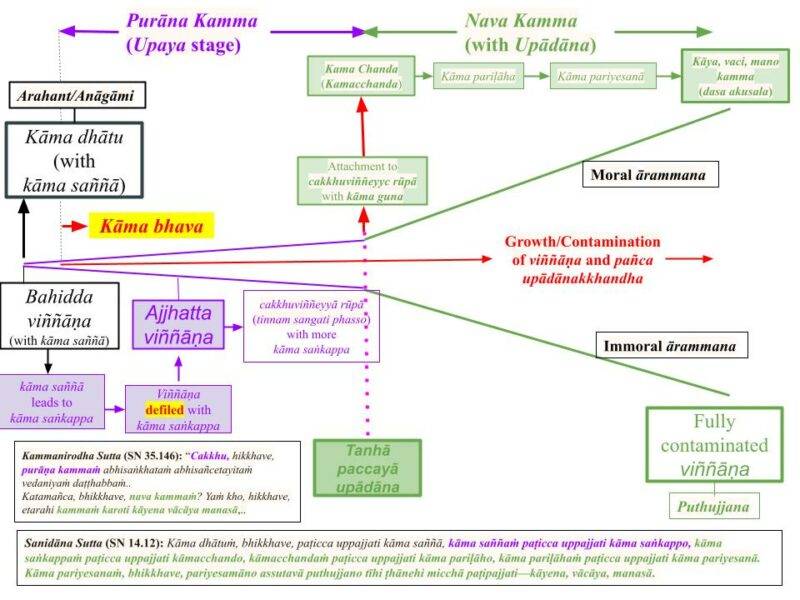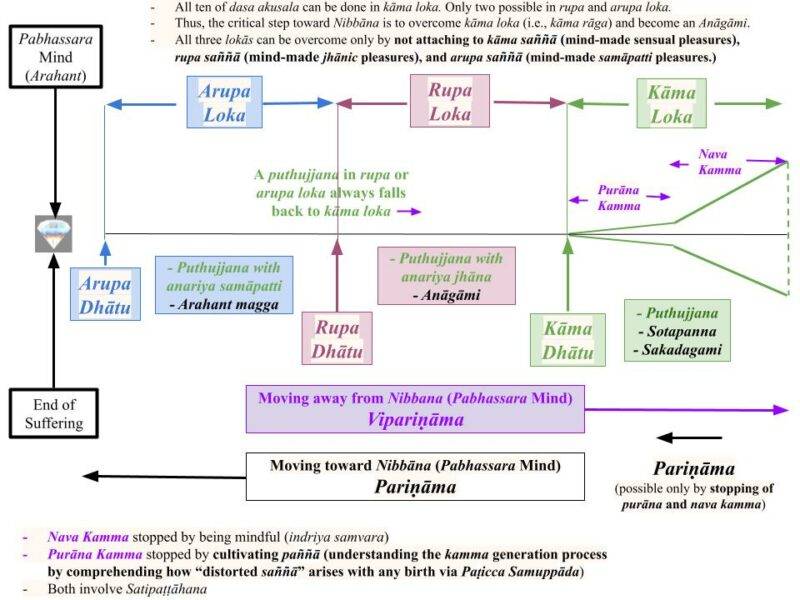- This topic has 15 replies, 3 voices, and was last updated 1 year ago by
dosakkhayo.
-
AuthorPosts
-
-
August 21, 2024 at 9:38 am #51515
dosakkhayo
ParticipantCitta, Manō, Viññāna – Nine Stages of a Thought
13. However, in the case of an Arahant, the process stops at the mānasan stage and thus will not contaminate with rāga, dosa, or moha.
- Their minds will also reach the viññānakkhandha stage without going through the above steps (as described).
___
I don’t understand this part well. I would appreciate it if you could explain it further.
So Arahant’s mind will reach viññānakkhandha stage like citta -> mano -> manasam -> viññānakkhandha?
Or, citta (without san) -> mano (without san) -> mānasan (without san) -> hadayan (without san) -> paṇḍaran (without san) -> mano manāyatanaṃ (without san) -> manindriyaṃ (without san) -> viññāṇaṃ (without san) -> viññāṇakkhandho (without san)?
Lal’s Note on September 3, 2024: The above post will be redirected to the rewritten version: “Citta, Manō, Viññāna – Nine Stages of Mind Contamination“
-
August 21, 2024 at 3:04 pm #51519
Lal
KeymasterWe need to learn to think on our own rationally and also not to wander off to irrelevant subjects.
- Per the description in that post, citta, mano, and mānasan stages do not have any defilements. Arahant‘s mind would go through those stages per the reasons I gave, for example, to identify people.
- I also stated that there is no description in the Tipitaka about how the mind of an Arahant gets to the viññāṇakkhandha stage. There is no need for that either.
- Of course, the viññāṇakkhandha stage of an Arahant is not the same as that of a puthujjana. In particular, it would not have any defilements. But it should encompass past, future, and paccuppanna states of the mind (because an Arahant also can recall the past and may have some expectations for the future, like taking a bath later in the day.)
-
August 22, 2024 at 3:35 am #51529
dosakkhayo
ParticipantI’m having difficulty understanding these 9 stages of citta.
In citta vithi, the citta where purana kamma occurs and the citta where nava kamma occurs are different.
However, in the explanation of the 9 stages of defilement, why is it described as if purana evolves into nava within a single citta?
It doesn’t seem likely that the paṇḍaran stage would occur in atita bhanvanga citta in citta vithi.
So I’m beginning to wonder if perhaps cittaṃ mano mānasan hadayan paṇḍaran mano manāyatanaṃ manindriyaṃ viññāṇaṃ viññāṇakkhandho might not be describing a single citta, but rather the cumulative effect of multiple cittas (citta vithi).
If I’m off base here, please set me straight. Thanks.
-
August 22, 2024 at 6:03 am #51531
Lal
KeymasterAt the beginning of the post, it is stated: “A citta evolves into viññānakkhanda via nine stages.” See “Citta Evolving To Viññāna And Viññākkhanda In Nine Steps.
- The mind starts at the “citta” stage and evolves into the viññānakkhanda stage in a citta vithi. But that repeats over many citta vithi, and the javana power increases to the level of doing kamma after numerous citta vithi that occur within seconds.
- The citta, mano, mansan stages are within the “bahiddha vinnana” stage (which also takes place for an Arahant.)
- It gets to the ajjhatta vinnana stage when the mind attaches to the sensory input (i.e., the “distorted sanna.”) I think I mentioned that in the post. Again, that ajjhatta vinnana strengthens with time if the mind stays on that sensory input.
- So, the mind goes through the “purana kamma” and “nava kamma” stages also during that process.
-
August 22, 2024 at 8:45 am #51533
dosakkhayo
ParticipantOh, I had thought until now that the 9-stage evolution occurs in a single citta. If it occurs in a single citta vithi, then there’s no problem. Thank you for clarifying.
-
August 22, 2024 at 10:14 am #51541
pathfinder
ParticipantI had the same misconception that the 9 stages refer to the stages that a single citta goes through.
In Citta Vithi – Processing of Sense Inputs
Does it mean that the later steps of the citta vithi – Vottapanna, Javana, corresponds to the viññānakkhanda stage? And each of the 17 cittas in a citta vitthi can be somewhat mapped to the 9 step citta evolution?
-
August 22, 2024 at 10:27 am #51543
Lal
KeymasterAn “Idappaccayātā Paṭicca Samuppāda ” describes the same process (evolution of a mind) as described in “Citta Evolving To Viññāna And Viññākkhanda In Nine Steps.”
- ” Citta Vithi – Processing of Sense Inputs” describes the same process in a different way. They are all related.
- Another way of analysis: “Purāna and Nava Kamma – Sequence of Kamma Generation.”
All recent posts (over the past year, starting around 8/5/23) discuss various aspects of this process: “New / Revised Posts.”
1 user thanked author for this post.
-
August 22, 2024 at 7:59 pm #51557
dosakkhayo
ParticipantAmazingly Fast Time Evolution of a Thought (Citta)
3. Those nine stages of contamination during the lifetime of the fundamental unit of cognition (within a billionth of a second) are citta, manō, mānasan, hadayaṃ, pandaran, manō manāyatanam, mana indriyam (or manindriyam), viññāna, viññānakkhandha. A Tipiṭaka reference is given in the post, “Pabhassara Citta, Radiant Mind, and Bhavaṅga.”
- Amazingly, these nine steps occur within a split second, and the Buddha said there are billions of citta arising within the blink of an eye. Each citta has three stages: uppāda, ṭhiti, and bhaṅga. Those nine steps occur before the bhaṅga or the termination stage.
- It may be hard to believe, but we can prove this true with the following example.
___
I think this phrase is the reason why I came to see the 9-stage evolution of citta as occurring in a single citta.
This clearly conflicts with the idea that the 9-stage evolution occurs in a single citta vithi.
So, should I view the 9-stage evolution of citta vithi and the 9-stage evolution of citta as progressing separately?
1 user thanked author for this post.
-
August 23, 2024 at 5:49 am #51567
Lal
KeymasterYou have some valid points. I will take a look at it later today. Thank you!
1 user thanked author for this post.
-
August 23, 2024 at 6:26 pm #51590
Lal
KeymasterI need to rewrite the post. Unless I can finish it sooner, it will likely be the post for next week.
2 users thanked author for this post.
-
August 23, 2024 at 6:59 pm #51591
dosakkhayo
ParticipantThank you for your service.
-
September 3, 2024 at 7:09 am #51783
dosakkhayo
Participant#9 third bullet
- The last stage of viññānakkhandha embodies the fact that viññāna has taken into account the past events (atīta) and future expectations (anāgata), as well as the conditions at the current (paccuppanna) moment. It has taken into account the ajjhatta and bahiddda stages (that we recently discussed in detail). It has also taken into account the coarse (olārika) and fine/subtle (sukuma) kamma accumulated, all lower (hīna) and higher (paṇīta) realms it has experienced, whether that mind is far away from Nibbāna (dure) or close to (santike) it. In other words, it represents the current (paccuppanna) status of the mind based on all those factors.
Could you please write a post that explains these eleven categories in more detail? Thank you.
-
September 3, 2024 at 8:00 am #51784
Lal
KeymasterThe old post has been rewritten with a new title: “Citta, Manō, Viññāna – Nine Stages of Mind Contamination“
- Dosakkhayo quoted from that new post.
- Yes. I will try to do that ASAP.
1 user thanked author for this post.
-
October 12, 2024 at 1:15 pm #52397
dosakkhayo
ParticipantGiven the current situation, it seems like it will take a long time for the content I asked for on September 3, 2024, at 7:09 am to be posted. Could you possibly provide a brief explanation in the forum in the meantime?
-
October 12, 2024 at 4:17 pm #52398
Lal
KeymasterHopefully, the following description will give you a good idea. But feel free to ask questions.
1. Pancupadanakkhandha (PUK) accumulation occurs when a mind attaches to a sensory input (arammana.)
- For example, PUK accumulation does not occur while we are in sleep.
- Furthermore, the process never starts at the pancakkhandha state. Our minds attach to PUK and keep on adding to it.
2. The following figure shows the accumulation of PUK in kama loka (i.e., applicable to humans). The figure shows the expansion of vinnana, i.e., the build-up of vinnanakkhandha.
- It starts with a sensory input (arammana) leading to the registration of a rupa (six types: vanna rupa, sadda, gandha, rasa, pottabbha, dhamma) in mind. Those are NOT external rupa. Those mental rupas arise simultaneously with vedana, sanna, sankhara, and vinnana in mind.
- The chart below shows how a cakkhu viññāṇa starts with a rupa (visual) as a sensory input. A sensory event starts on the left at the “dhātu stage.” While the mind of an Arahant stops there, that of a puthujjana keeps evolving to the right, becoming increasingly defiled.

3. As we can see from the figure, a vinnana starts as a “bahidda vinnana” and immediately becomes an “ajjhatta vinnana” for a puthujjana.
- Rupa (that arises in mind), vedana, sanna, and sankhara associated with bahidda and ajjhatta vinnana also fall into those two categories. For example, the rupa also transitions from a bahidda rupa to an ajjhatta rupa.
- That is the beginning of the development of the 11 types.
4. Vinnana (and PUK) expand as the mind gets increasingly attached to the arammana. The expansion of vinnana (in two stages of purana kamma and nava kamma) is shown in the figure.
- That is a highly complex process. During both stages, the mind recalls similar previous events (atita vinnana) and also generates expectations of similar vinnana in the future (anagata vinnana). They have associated rupa (that arises in mind), vedana, sanna, and sankhara. Of course, paccuppanna vinnana arises at each moment.
- Those are the atita, anagata, and paccuppanna components of PUK.
5. So far, we have discussed five of the 11 components. To get an idea of the rest, we need to look at the “bigger picture,” including rupa and arupa loka relative to Nibbana (or the pabhassara mind). That figure is shown below.

6. Similar processes occur for rupa loka and arupa loka Brahmas (details not shown). While the mind of a being (say a human) in kama loka falls on “kama dhatu” and proceeds to the bahiddha vinnana stage, a rupa loka Brahma‘s mind would fall on “rupa dhatu” and proceed to the bahidda vinnana stage (and go through the subsequent similar steps).
- All five entities in PUK proceed the same way in rupa and arupa loka.
7. As we can see from the second figure, kama loka is the furthest from Nibbana. Rupa loka is next, and arupa loka is the closest to Nibbana.
- Thus, the five entities associated with the kama loka are labeled “dure” (far away), and the other two are closer (santike).
- In the same way, the five entities associated with the kama loka are labeled coarse (olārika), and the other two are finer (sukuma).
- In the same way, the five entities associated with the kama loka are labeled inferior (hīna), and the other two superior (paṇīta).
8. That is a brief description of the 11 types of PUK.
Note: The top figure is from “Purāna and Nava Kamma – Sequence of Kamma Generation” and the second figure from “Vipariṇāma – Two Meanings.”
2 users thanked author for this post.
-
October 12, 2024 at 8:15 pm #52405
dosakkhayo
ParticipantSadhu! Sadhu! Sadhu!
-
-
AuthorPosts
- You must be logged in to reply to this topic.


